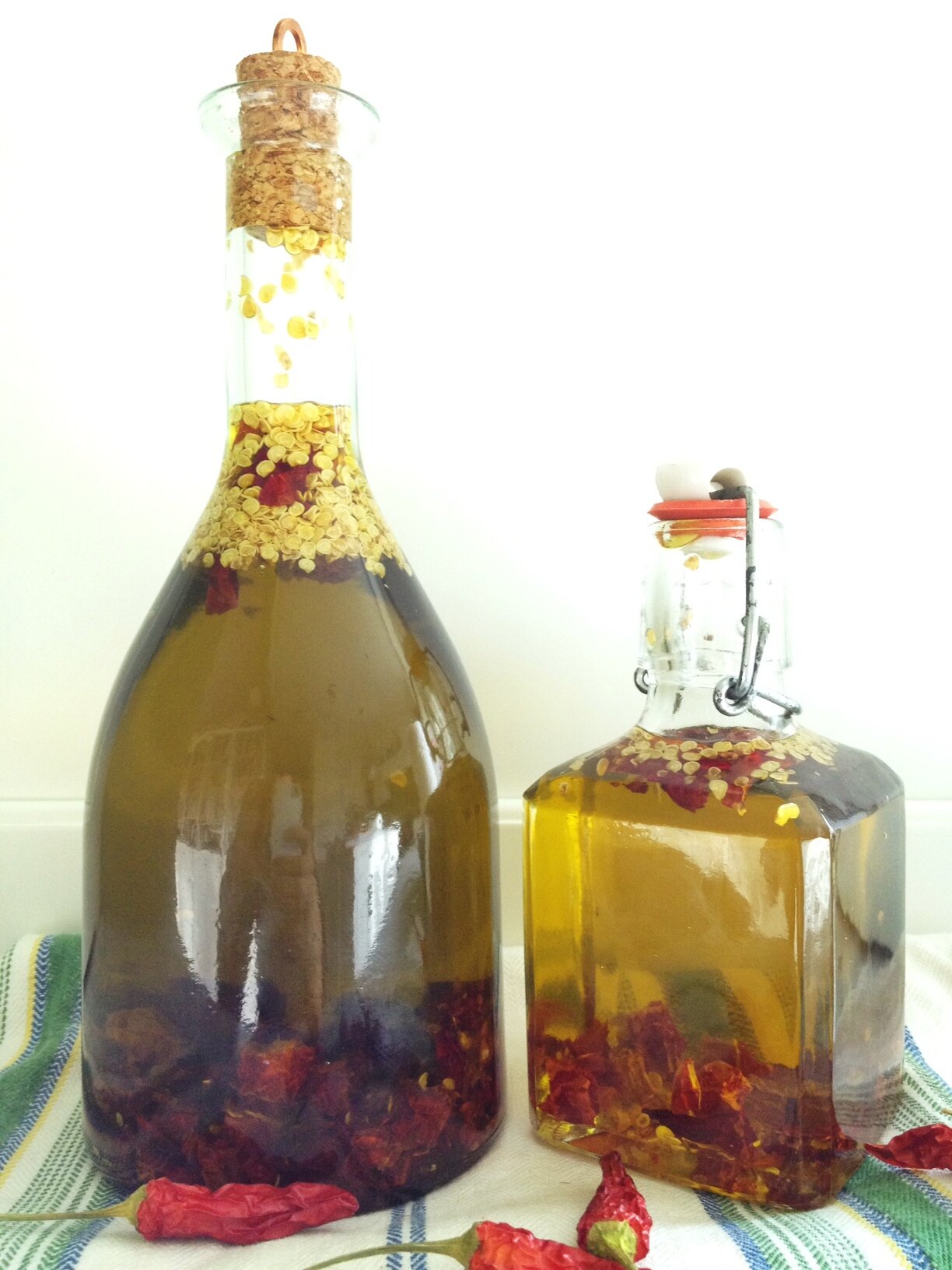Olio Santo ~ Abruzzo's Hot Pepper Oil
A distant cousin once entertained my sister and me at the dinner table by eating whole hot peppers. We were little and thought he was crazy, but he was Abruzzese, and as I came to learn first-hand, we Abruzzesi love our peperoncini.
No matter where you sit down for a meal in Abruzzo, whether at a restaurant or at someone's kitchen table, there will almost always be peperoncino ~ chili pepper. In summer it is likely to be a single fresh peperoncino, red or green, served on a plate with a knife or a pair of little scissors next to it for snipping. Sometimes it's a small bowl of dried, crushed peperoncini.
And sometimes it's olio santo, which translates to ‘holy oil.’ Hot oil. Olio santo is a staple all over southern Italy, made by infusing extra-virgin olive oil with fresh or dried chili peppers and letting it steep until the oil is tinged red and fiery hot. "It should be called olio diabolico," a friend recently said. That's how spicy it can be.
There’s something reverential about the way olio santo is used. It's meant to be employed with care, spooned judiciously over maccheroni alla chitarra or roasted fish, poured in droplets over boiled escarole or rustic soups. You don't douse a dish with olio santo, you anoint it. It's hard to imagine an Abruzzese meal without it.
Olio santo is easy to to make, and worth having in your pantry as a finishing touch for anything from pasta and pizza to grilled vegetables or steak. I like a few drops on fried or scrambled eggs in the morning. It can be made with either fresh, half-dried or dried hot peppers, and every cook has his or her own preferred method.
I meant to make a batch last summer with fresh peppers from my prolific little plant. There's a vendor at my farmers' market who sells a compact, bushy plant called super chili, and I buy one every year. It produces all summer long and well into fall, in spite of aggressive neglect by me. The peppers are plump, 1 to 2 inches in length and about as spicy as a cayenne pepper, rating 50,000 on the Scoville heat unit scale. They are perfect for making olio santo.
Making the oil with fresh peppers involves steeping them in a hot vinegar brine, letting them dry, and then marinating them in oil. All summer long I picked peppers as they turned from flame to red and tossed them into a bowl on my kitchen counter. I kept meaning to slice some up to immerse in oil. Instead, the weeks passed and the peppers shriveled and dried up ~ perfectly, as it turns out, right in the bowl. They turned crispy without turning moldy, and they retained their bright red color.
Finally, I blitzed half of them in the food processor to make crushed red pepper flakes. I used the other half to make olio santo, skipping the brining process since the peppers were completely dry. I snipped the stems off the peppers and cut them into small pieces. I put them in glass bottles and filled the bottles with good extra-virgin olive oil. (If you don't happen to have a bowlful of dried hot chili peppers hanging around you can buy them at just about any well-stocked supermarket and at ethnic grocery stores.)
Now comes the hard part ~ waiting the two to three weeks necessary for the peppers to settle and the oil to become properly infused. Olio santo will last for at least six months kept in a cool, dark place (the longer it sits the more potent it gets), which is perfect timing as by then it will be summer and, with any luck, there will be a new crop of peppers ready for picking.
OLIO SANTO ~ HOT PEPPER OIL
Makes about 1 pint (2 cups)
Ingredients
1 to 2 dozen dried chili peppers (or more or less according to taste)
2 cups good quality extra-virgin olive oil
Instructions
Use a sharp paring knife or scissors to snip the stem end off the peppers. Then cut the peppers crosswise into small pieces. Corral any seeds that try to escape. You may want to use kitchen gloves for this task to avoid getting pepper residue on your fingers.
Put the snipped peppers and their seeds into a bottle or jar, then fill the bottle or jar with oil. Close tightly with a stopper or lid and set in a cool, dark place for 2 to 3 weeks to allow the heat of the peppers to infuse the oil.


